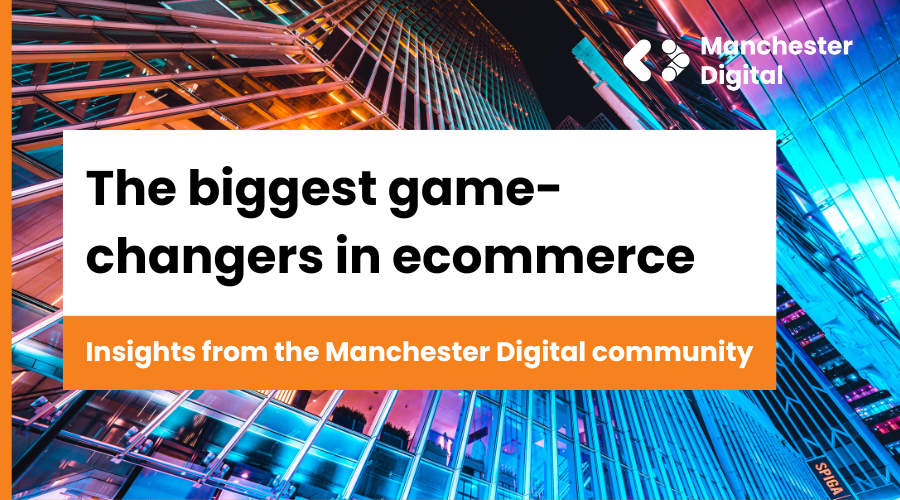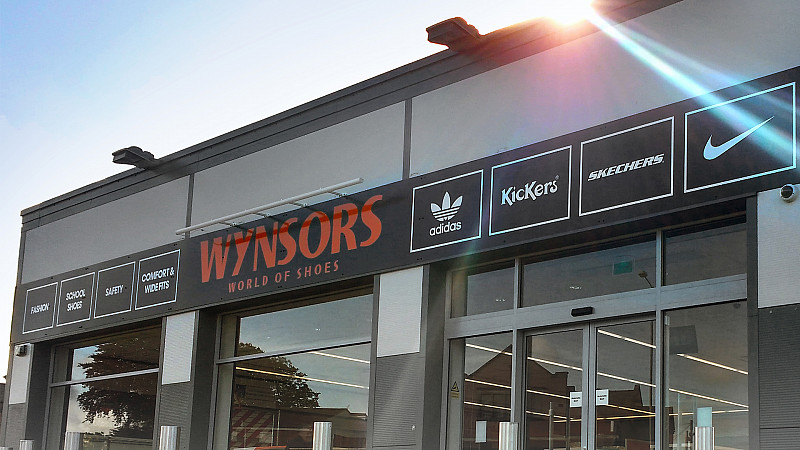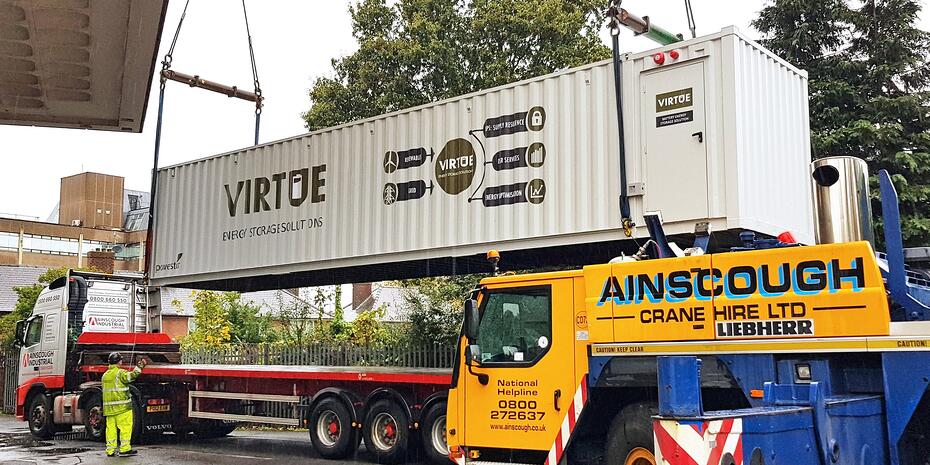
Off the back of our 2025 Ecommerce Conference, we asked the Manchester Digital community one simple question: What has truly moved the needle in digital commerce?
From the rise of AI-powered personalisation to game-changing innovations in payments and fulfilment, ecommerce continues to evolve at pace. But which developments are making the biggest difference to businesses and customers right now?
In this post, our members share the tools, tactics and technologies they believe are redefining the ecommerce experience.
PushON
AI in Ecommerce
AI is the hot topic in eCommerce, but many still don’t fully understand how to use it effectively. It isn’t a magic wand. But what it can do can seem like magic if you have someone skilled in AI deployment. The truth is that AI personalisation can be game-changing but only when executed well. You still need the AI wrangler.
At its best, AI personalisation continuously refines itself. Initially, it identifies patterns from similar customers, but over time, it hones in on an individual’s unique preferences. This dynamic learning process means that AI can surface the right product at the right time, driving conversion rates. But the impact goes far beyond that.
A truly personalised experience is about creating value beyond transactions. AI can help deliver relevant content, learning resources, and tailored tools that position your brand as more than just a retailer. This builds trust and makes your business the go-to destination for customers looking for insights and solutions.
The real magic of AI is how well it understands and serves your customer. Get that right, and you will keep them coming back.
Find out more about PushON here.
CyberLab
Cyber Security: The Hidden Engine Behind E-commerce Success
AI personalisation, payment innovation, and fulfilment speed often dominate the conversation around e-commerce. But behind every successful online store is something far less glamorous, yet critical: cyber security. Without strong protection in place, even the most advanced e-commerce platform is vulnerable to cyber attacks that can compromise customer data, disrupt operations, and erode trust.
Online retailers face a surge in threats such as phishing, payment fraud, and web application attacks, making cyber security essential. Beyond protecting data, it enhances trust, supports compliance with regulations like PCI DSS and GDPR, and ultimately improves business performance.
Modern e-commerce platforms rely heavily on web applications, which are a prime target for cyber criminals. Securing these applications with measures such as Web Application Firewalls (WAFs), vulnerability testing, and secure coding practices helps prevent breaches and downtime that can damage revenue and reputation. The rise of AI-driven tools has also increased risk, as threat actors use sophisticated automation to scale attacks and bypass traditional defences.
Compliance is another crucial pillar. Meeting regulatory requirements isn’t only about avoiding fines, it reassures customers that their data is handled responsibly. Combining compliance-driven controls with user-focused protections like multi-factor authentication and secure payment gateways creates a seamless, trustworthy experience.
We saw this in action when supporting Sealey Tools, one of the UK’s leading tool and equipment suppliers. By strengthening their cyber security posture, we helped them build digital trust and scale their e-commerce platform securely.
Treating cyber security as a strategic enabler positions e-commerce businesses to grow confidently and sustainably.
Find out more about CyberLab here.
The Big Partnership
Genuine game-changers in online retail
UK brands face a rapidly evolving e-commerce landscape. Those keeping pace are seeing remarkable results, while others risk being left behind. At BIG, we've been tracking which innovations actually move the needle for our clients, here's what's genuinely changing the game in online retail right now.
From Hype to Results, AI That Impacts Revenue
Let's be honest, there's plenty of hype around AI. But what matters is how it affects your bottom line.
We worked with a regional airline to reshape their marketing approach. By analysing customer behaviour patterns, we helped them target their spending more effectively, resulting in a 37% ROI improvement.
What made the difference? Not buzzwords, but practical insights. Our systems spot patterns in how people browse and buy. For both regional airlines and Scottish Premiership clubs, this has led to conversion improvements of up to 29%. These aren't theoretical projections – they're results from real campaigns.
Social Media Becomes the Storefront
The lines between social media and shopping have practically disappeared. UK consumers now spend £9.2 billion through social platforms, with football fans leading the charge. Three-quarters of young supporters now buy tickets and merchandise directly through social feeds.
We've helped a Scottish Premiership club adapt to these changing behaviours. By integrating social content with tailored purchasing pathways, they've connected with new audience segments while maintaining their established supporter base. The shift has led to noticeable growth in digital ticket sales and merchandise revenue, particularly among younger demographics.
Personalisation That Adapts in Real Time
People expect websites to understand them these days. Generic customer journeys simply don't cut it anymore.
Our work focuses on creating experiences that adapt to each visitor. When someone visits a regional airline's site repeatedly searching for weekend breaks, the site recognises this interest and highlights relevant offers. For a football club, returning fans see content tailored to their past purchases – whether that's hospitality packages or away game tickets.
This personalisation makes a real difference. Abandoned bookings drop, and people tend to spend more when they feel understood.
Sustainability Strategies That Drive Growth
Sustainability matters to consumers more than ever. According to SAP research, 46% of UK buyers actively consider environmental practices before making purchases.
Our airline clients see real benefits from communicating their fuel efficiency measures. Similarly, football clubs find that highlighting their community initiatives resonates with supporters. Our tracking shows clear connections between these messages and increased customer loyalty – not just feel-good metrics but repeat purchases and higher lifetime value.
Connected Experience Across All Touchpoints
Most people don't think in channels – they simply want to interact with your brand however is most convenient at that moment.
A Scottish Premiership club was surprised to discover that 26% of their ticket sales involved multiple touchpoints; perhaps starting on social media, continuing on their website, and finishing with a phone call. After spotting this pattern, we developed a connected data strategy that tracked individual fan journeys across platforms. Once we helped them connect these dots and strengthen each transition point, qualified leads jumped by 32%. This translated directly into higher match attendance and merchandise sales, with a particular increase in hospitality packages.
Focusing on What Truly Matters
The most successful brands aren't necessarily using more technology, they're using it more thoughtfully. Looking ahead to 2025, we're seeing personalisation and connected experiences delivering the strongest return on investment for our clients businesses. These aren't just passing trends but fundamental shifts in how consumers expect to interact with brands online.
As the online retail space continues to evolve, staying competitive won't just be about adopting every new technology. It'll be about focusing on the innovations that actually matter to your customers and implementing them with purpose. Those who master this balance will be the ones leading their sectors in the increasingly digital marketplace.
Interested in discussing how these e-commerce game-changers might apply to your business? Drop us a line at digital@bigpartnership.co.uk or visit our Manchester office for a coffee and a chat about your digital ambitions.
Sources: The Delivery Conference 2025, VentureBeat, SAP
Find out more about Big Partnership here.
Bring
Ecommerce’s Shift to Smarter Growth
Our 2025 eCommerce Playbook report – launching soon – offers an early glimpse into what the industry’s most influential voices are anticipating for the year ahead. Despite ongoing market turbulence, the prevailing mood among contributors is one of strategic optimism. Many expect B2B to outpace B2C in growth, with brands increasingly focused on operational efficiency, smarter tech investments, and more resilient revenue strategies. The days of bloated tech stacks and over-reliance on paid media appear numbered, as businesses look inward – towards owned channels, first-party data, and smarter use of AI – to drive long-term performance.
There’s also a clear shift in how brands are thinking about customer experience and retention. From the role of agentic AI to the rise of social commerce and mobile innovation, the report highlights the technologies and tactics gaining traction – and those falling out of favour. But it’s not all about tools: this year, mindset matters just as much. Our experts point to a growing emphasis on profitability, sustainability with substance, and experience-led loyalty over shallow incentives. There’s much more to uncover when the full report lands – including which trends are truly transformative, and which may not live up to the hype.
Find out more about Bring here.
Chainalysis
Is Crypto Retail’s Missed Opportunity?
Having been involved with cryptocurrency for over a decade, I honestly thought wider adoption in retail, both online and on the high street, would be more prevalent by now. I even imagined my daughters using bitcoin for school dinners. Yet, here we are with traditional Direct Debits still ruling the roost.
Why should cryptocurrency be attractive for retail? Several local retailers have asked me this, curious about tapping into the growing crypto user base. Cryptocurrency offers peer-to-peer transactions, often bypassing intermediaries, much like cash. Depending on the specific crypto, transaction speeds can rival other methods, and fees are frequently lower than traditional processors. Add in near-instant, low-cost international payments, and it seems like a strong case for crypto in retail. However, it hasn’t quite found its footing yet.
Retailers may view crypto as an unnecessary hurdle. Regulation concerns, setup costs, and the need for staff training can be deterrents. On the other hand, most mainstream buyers aren't clamoring to pay with crypto just yet. Existing methods like contactless and mobile wallets are simple and convenient, lessening the push for crypto adoption.
Most buyers don't think about processing fees, unlike crypto transactions that often require fee specification up front. Plus, traditional methods offer incentives like cashback and rewards. A leading advantage of crypto is privacy, allowing transactions without sharing personal information with intermediaries. While not a primary concern for most shoppers now, increasing digital reliance could change that. Despite these challenges, there's growing interest, and some highstreet businesses now accept crypto online and you can even buy your fish and chips and sushi in Manchester with bitcoin!
Find out more about Chainalysis here.
CloudGuard
How Automation-Driven SOCs Are Changing E-Commerce Security
E-commerce platforms are under constant attack, facing everything from account takeovers and payment fraud to large-scale bot-driven exploits. These threats can move fast, and for many security teams, keeping up is difficult. Without automation, detection is slow, response times lag and real threats slip through.
This is where automation-driven SOCs have fundamentally changed how e-commerce businesses respond to cyber incidents. Integrating automated detection and response capabilities with expert human oversight allows modern SOCs cut down the time it takes to identify, investigate, and contain security incidents. Advanced threat intelligence, behavioural anomaly detection, and automated response workflows allow SOCs to shut down attacks in real time, before they end up impacting customers or revenue.
For example, automation can correlate multiple security signals across an e-commerce platform, identifying attacks such as credential stuffing in seconds. Instead of relying on reactive security measures, predefined playbooks can immediately trigger a response - locking out compromised accounts, blocking malicious traffic, and preventing fraud before customers are affected.
Like anything, automation can’t be solely relied upon. Threats evolve, and bad actors continuously adapt their techniques - this is why expert security teams remain a critical piece of the puzzle to fine-tune automation, interpret complex attack patterns, and ensure defences can prevent breaches before they escalate.
For e-commerce businesses, an automation-driven security approach is no longer a luxury. As cyber threats continue to grow in volume and complexity, businesses need security that scales with them – protecting transactions, customer data and brand reputation, without disrupting the customer experience.
Find out more about Cloudguard here.
CTI Digital
The rapid evolution and adoption of CRO driven by personalisation and data-led UX
One of the most impactful trends CTI Digital has observed recently is the rapid evolution and adoption of Conversion Rate Optimisation (CRO) driven by personalisation and data-led UX. While many eCommerce businesses have focused on traffic acquisition, we’ve seen the most meaningful commercial gains come from improving how that traffic converts, particularly through personalised shopping experiences powered by real-time customer data.
By leveraging behavioural analytics, heatmaps, session recordings and A/B testing, our clients are able to serve tailored content, adjust product recommendations and optimise calls-to-action based on individual user segments and buying intent. Tools like Klaviyo, Luigi's Box, Advanced Commerce and Shopify’s native personalisation features have enabled this to be scaled effectively on different eCommerce platforms.
This trend is especially impactful in the UK, where competition is fierce, and customer expectations for convenience and relevance are high. We’ve seen an uplift in both conversion rates and average order value (AOV) when brands move away from static, one-size-fits-all content and merchandising to instead create journeys that respond to each shopper’s behaviour and intent.
In a retail climate where customer acquisition costs are rising, CRO-led personalisation offers strong ROI, delivering incremental gains that compound over time. It also supports other key business objectives, from improving retention through better post-purchase experiences, to reducing bounce rates and increasing revenue per visitor.
This strategic focus on CRO and personalisation isn’t just a fleeting trend, it’s become a cornerstone of our clients eCommerce success.
Find out more about CTI Digital here.
Nexer Digital
The Accessibility Advantage
The European Accessibility Act (EAA), coming into effect in June 2025, is set to shift expectations for eCommerce businesses operating in or targeting the European Union. The legislation requires that digital products and services are accessible to everyone, including people with disabilities.
For eCommerce, this means ensuring product information, payment systems, customer authentication and after sales support are all accessible. These requirements align with international standards like the Web Content Accessibility Guidelines (WCAG), but compliance should be seen as a starting point, not the end goal.
Meeting the legal standard is, of course, important, but there is a golden opportunity in going beyond this. Creating truly inclusive customer experiences helps businesses stand out, strengthen their reputation and customer loyalty, and reach an estimated 20% more of the market.
For UK-based businesses, the EAA still matters. If your platform serves customers in the EU, you’ll still need to comply. By prioritising accessibility now, businesses can future-proof their products and services, and demonstrate a genuine commitment to inclusion.
Find out more about Nexer Digital here.
Scurri
The Post-Purchase Experience
For Scurri, one of the biggest game changers is a heightened expectation amongst consumers for the post-purchase experience. These higher expectations are driving innovation amongst eCommerce retailers, as more retailers seek to deploy post-purchase software that optimises the delivery experience.
We recently conducted a survey of over 1,000 UK consumers and hundreds of UK retailers. In our report, we identified that 60% of UK shoppers would abandon a purchase due to poor delivery options. Furthermore, we uncovered that 53% of UK consumers say shipping costs and speed are the key purchase considerations across channels. These trends all point toward higher expectations amongst consumers, who increasingly view the delivery experience as an extension of the brand they have bought into.
We predict these increased expectations for an optimal delivery experience will drive more and more retailers to invest in the customer delivery experience. Increasingly, the delivery promise will come under scrutiny and brands who live up to their delivery promise will succeed. Similarly, this heightened interest in an optimal delivery experience will result in retailers communicating their delivery options at an earlier stage in the buying journey.
Our report also uncovers a rapid increase in AI adoption, with 46% of enterprise retailers heavily focused on adopting AI to drive both efficiency and improve customer experience.
To request a copy of "The future of delivery and post purchase" report which contains the full results from our survey of 1,000 UK consumers and hundreds of retailers, visit scurri.com/insights
Find out more about Scurri here.
Venditan
Loyalty & Membership
Over the past decade, loyalty and membership programmes have become fundamental to modern retail. Major players like Boots with its Advantage Card and Tesco’s Clubcard have cemented these programmes as an integral part of the shopping experience. Once reserved for the giants of retail, loyalty schemes have now become ingrained in the public consciousness and are gaining momentum across mid-market retailers and SMEs, all seeking to replicate the customer retention and lifetime value enjoyed by larger brands.
At Venditan, we’ve seen firsthand how well-executed loyalty programmes can significantly impact eCommerce success. The introduction of a loyalty programme often leads to a direct uplift in repeat purchase rates, average order value (AOV), and customer lifetime value (CLTV). This data-driven approach helps businesses foster long-term relationships with their customers while increasing overall profitability.
However, one of the key challenges for mid-market businesses has been the accessibility of affordable loyalty solutions. Many existing systems come with hefty price tags or require complex integrations, making them difficult for smaller retailers to implement effectively.
Recognising this, we integrated a fully functional loyalty system directly into Venditan Commerce, designed to be easy to implement and manage across all sales channels—online, in-store, and mobile. This eliminates the need for third-party integrations, allowing our clients to configure, launch and manage their own programmes, driving value for themselves and their customers.
In an increasingly competitive market, loyalty programmes have become a key differentiator, offering businesses the tools to retain customers, increase sales, and stay ahead of the competition.
Find out more about Venditan here.









